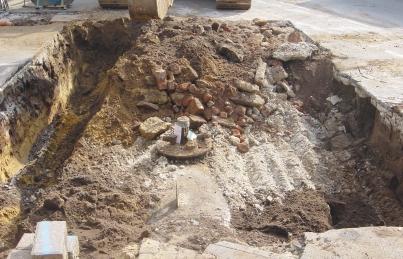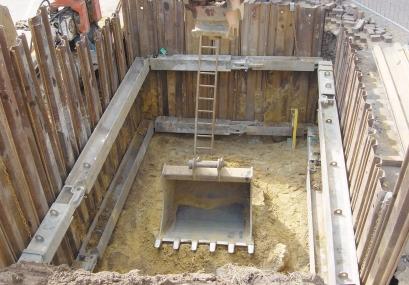
12 minute read
Press Releases
By Paul Reyner, Regional Manager - OPW UK
With the highly competitive market in fuel distribution, companies today are concerned not only with environmental compliance and leak detection but also with tighter control of fuel inventory.
Advertisement
High volume retailer demands have dramatically changed the performance requirements of today's automatic tank gauge systems. Emphasis at these high volume sites is focused on monitoring and controlling fuel usage from a central location. Huge increases in volume dispensed require constant attention to avoid fuel run outs. The volume of fuel dispensed has increased dramatically from 600 to 700 thousand liters a month to as much as 2 million or more liters a month for high volume locations. There is increased demand to automate manual processes as well as improve the accuracy of the data collected.
Leak detection is a small component of fuel management today. The total picture of fuel management consists not only of detecting leaks to the environment and eliminating the loss of product through inaccurate meters, theft of product and inaccurate deliveries, but also ensuring the business does not run out of fuel as the volume pumped grows.
This demand for automation and greater accuracy has driven the continuous development of OPW fuel management products to include PC based software to manage fueling operations from a central location and precision inventory reconciliation within the automatic tank gauge for greater accuracy and lower operating costs.
OPW SmartTalk™ PC based software integrates the functionality of the OPW Galaxy and Site Sentinel Series of automatic tank gauges into the PC environment and provides real time access to data. SmartTalk provides the owner/operator of the facility with a graphical representation of all tank inventory levels as well as the associated height/volume information in a text format. All reports that were printed in the past on the system printer can now be printed out on the PC's printer. Polled information is automatically saved in the database and can be easily exported to other management programs.
OPW Galaxy Precision Inventory Reconciliation feature integrates automatic calibration of tanks and automatic reconciliation of liquid fuel inventory into the Galaxy automatic tank gauge. It highlights discrepancies in delivery and sales data, qualifying the data and eliminating sources of errors for the station owner. The Precision Inventory Reconciliation reports quickly enable the owner/operator to view inventory trends and spot exceptions. Additionally, it saves hours each day, each week and each month from manually collecting data and filling out burdensome reports to account for fuel being sold, fuel being delivered and the remaining fuel in the tank.
Additional costs savings associated with tight, more accurate, control of the liquid inventory are eliminating stock outages, return loads and rush orders. This real time measurement and collection of data provides maximum performance in the ability to accurately measure the amount of fuel in the tank and the fuel being pumped through the dispensers.
Data Collection
The data used in the reconciliation process is collected, processed and converted from raw heights & temperatures to volume. The resulting volumes are then compared to the opening volumes to calculate an observed or measured (physical tank) sales volume. Meter readings are compared to the opening meter readings to calculate metered sales volumes. The metered and measured amounts are added to the daily cumulative volumes and are used to generate the monthly inventory control (MIC) reports.
Additionally, the data is checked to see if a delivery or water removal has occurred. If so, the delivery or removal amounts are calculated and stored for the reports.
The reconciliation reports are available in either net or gross volume. These are also available on a current month or stored months' basis.
The Monthly Inventory Control report provides for each day the opening volume (physically measured), the metered sales, calculated volume (opening-metered), the ending volume (physically measured), and a corresponding over/short (ending volume-calculated volume). In addition, it provides a total delivery and
total other adjustments line, which can be water removed from the tank or fuel added back to the tank because someone has performed a meter calibration. Further, it provides a total monthly sales, total monthly over/short, over/short as a percentage of sales, 30day average over/short, a 30-day average over/short as a percentage of sales, and an allowable over/short indication.
Tank Strapping
The tank-strapping feature, which is a key feature in Precision Inventory Reconciliation, provides the ability to accurately measure the amount of product in the tank as well as what is dispensed during the course of doing business daily. This feature attempts to develop or adjust a tank chart for converting fuel heights to volumes and minimizing the over/short net values. The original tank chart can be entered by any number of methods, including choosing a pre-built fiberglass chart, entering the dimensions for a steel tank, or manually entering tank points at selected locations.
Regardless of the input method, the internal Galaxy software creates a tank chart that stores a volume for every inch. Metered sales and measured sales are compared statistically to produce a more accurate tank chart in the system.
Meter Mapping
Key to the process of tank strapping or tank calibration is mapping the meters to the tanks. Mapping the meters to the tanks is an integral component of the operation of Precision Inventory reconciliation and this process determines which dispenser meters are linked to which tank for an accurate account of fuel dispensed from each tank. This process can be performed automatically through the Galaxy Console or by manually entering the information into the Galaxy Console.
Volumetric Tank Leak Detection
In Tank Leak Detection is available on all OPW tank gauges because the in tank probes are designed to produce the maximum accuracy to achieve the 0.4 lph standards required. For Sites that do not operate on a 24-hour basis the ability to perform a volumetric tank test enables the site to monitor their tanks for very small leaks this ensures that any stock losses from the tanks can be quickly detected and action taken. This is particularly important where the site has single skin steel or fiberglass tanks where older dealer sites tend to have. The OPW Site Sentinel 1 performs the test as and when the tank is inactive for a minimum of 2 hours although it is possible for the system to produce a result in less time. With the OPW Galaxy system the timing of the test can be preprogrammed to suit the operational requirements of the site.
For those sites that have to operate continuously 24 hours a day 7 days a week the OPW Galaxy SLD (Segmented Leak Detection) software features an advance method of leak detection for the Galaxy tank gauging system. Taking advantage of the Galaxy systems in-tank leak detection capabilities, SLD provides the ability to collect data from the tank and conduct an EPA certified 0.8 lph leak test without shutting down the tanks.
The Galaxy with the SLD feature continuously collects product height and temperature information from the tank, determining when idle periods in the tank begin and end. The idle period information is evaluated qualified and only the best information is stored to form a highly accurate database of information.
Highly evolved analysis techniques in SLD constantly evaluate new and existing information the database to perform a leak test on only the most highly qualified information. Aleak test is performed each time idle period information is added to the database.
Since the idle period information is always being updated, the leak tests performed by SLD are always current and accurate. Test results are provided every 24 hours by either the press of a button to access up to the minute leak test results or automatically by programming the system. These can be printed, faxed or remotely retrieved electronically every 24 hours. There are four different automatic reports available for SLD.
Greater accuracy reduced false alarms
SLD's algorithms qualify all of the available leak tests data, using only the highest quality data to perform its leak detect test. False alarms are greatly reduced because invalid data is thrown out and only the best data is used. Because leak test data is collected continuously and updated frequently, the response time to detect leaks is shorter than that of a scheduled static leak test. SLD is simple and very easy to use. The owner or operator doesn't have to program in a scheduled leak test time, since the tests are continuously run and the results are automatically printed. SLD is an advanced, accurate and reliable method of leak detection, important to the profitability of every business or company regardless of the size.
As well as tank based leak detection system OPW Tank Gauges can also provide leak detection for Interstitial Spaces in double wall tanks, Sump leak detection monitoring, both liquid and vapour, sensors for Monitoring wells and For those with pressurized pumping systems OPW can provide highly accurate Line Leak Detection Systems.
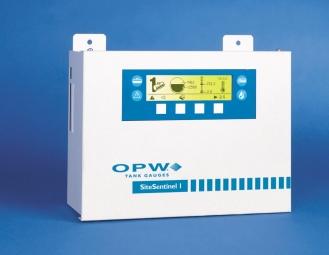
APEAAnnual Conference, Exhibition and Dinner Thursday 13th October 2005
By Brian Baker, APEAChairman
This year's theme looks to the future of what will be coming into the downstream Petrol Filling Station Market. Research is taking place all over the world in the pursuit of alternative energies and fuels. The APEA will be reflecting some of these changes with an interesting and though provoking schedule for this year's Conference
Conference/Exhibition
There is also our interesting Exhibition to show the very latest technology that is available in our industry and experts on hand to explain their wares and what is on offer.
Doors to the exhibition hall open at 10:00 am when visitors can enjoy tea or coffee whilst registering and then have the opportunity to visit the exhibition stands which compliment the conference. The conference session begins at 11:00 with a welcome by Brian Baker, Chairman of the APEA.
Following Brian's welcome, Brian will introduce the speakers covering this years theme of ‘What’s Coming Next?’.
Speakers are eminent in their respective fields and will be explaining ground breaking issues that will soon affect the industry.
Whether you are a contractor, supplier, specifier, regulator, oil company, supermarket, dealer book your place now to attend.
You are also welcome to bring a colleague along to see what your Association does for the industry.
Dinner
To compliment the exhibition and conference the APEA is holding its ever popular Dinner in the Kings Suite at the Metropole. Pre dinner drinks are being served from 19:15 with dinner guests taking their places at 20:00. For your entertainment Brian Newbold will be giving an after dinner speech.
Accommodation
The APEAhave also reserved 80 rooms on 13th October at the hotel at discounted rates should you wish to stay overnight. Rooms can be booked directly with the hotel on 0121 780 4242 quoting the APEAevent.
What to do if you wish to attend? Conference - If you wish to attend the conference and exhibition please contact Jane Mardell on 01799 502929 or by email at admin@apea.org.uk at the APEAoffice to register. Named badges will be available on the day.
What the day offers
LIVELYEDUCATIONAL CONFERENCE SESSION
OPPORTUNITYTO MAKE COMMENTS AND SUGGESTIONS DURING THE Q&ASESSION
OPPORTUNITYTO MEET WITH COLLEAGUES, FRIENDS & SUPPLIERS EXHIBITION OFINNOVATIVE PRODUCTS AND SERVICES
OPPORTUNITYTO REMAIN ABREAST OFAND UNDERSTAND ADVANCES IN TECHNOLOGYAS THEY HAPPEN
IFREQUESTED, CERTIFICATE OFATTENDANCE IN ACCORDANCE WITH PROFESSIONAL DEVELOPMENT PROGRAMME WILLBE ISSUED
Conference and Exhibition - Westminster Suite
9.30 - 10.30 Arrival/refreshments
10.30 - 11.00 Renewable Energy in the Building Industry Ray Noble UK Commercial Manager BPSolar
11.00 - 11.30 UK Hydrogen Speaker from BP
11.30 - 12.00 Nano-technolgy for Petrol Filling Stations Professor Kerry Gardiner
12.00 - 2.00 Lunch
2.00 - 2.30 Stage 2 Vapour Recovery Speaker TBC
3.00 - 3.30 Stage 2 Vapour Recovery Mike Jennings, Gilbarco Veeder-Root
4.00 Exhibition closes
Dinner - Kings Suite
7.15 - 8.00 Pre - Dinner drinks
8.00 Dinner with after dinner speaker Brian Newbold
By Paul Craven, Trading Standards Officer, Suffolk County Council
Aleak from an underground tank is a major concern for any petrol station owner. This nightmare became a reality for one petrol station in Suffolk. The situation could have been a lot worse had it not been for a swift, direct, joined up response from Suffolk County Council's Trading Standards department, the Environment Agency and Suffolk & Essex water.
In June 2004 Trading Standards received a call from Bob Smith the owner of Crisps Paramount Garage, Knodishall.
He believed over 8,000 litres of diesel stored in one of his underground tanks had disappeared. Suffolk's trading standards officers knew immediately the seriousness of the situation as the garage was close to three water boreholes. The nearby pumping station that supplied the boreholes pumped around 5 million litres of drinking water a day. Without swift action the boreholes would become contaminated and be out of action for a very long time, perhaps forever. This would have caused significant disruption to the local water supply. Agency and Suffolk and Essex Water to let them know about the situation.
An inspection of the tank revealed a hole around 10mm in diameter caused by Microbial Induced Corrosion (MIC). MIC thrives in a dormant environment where it has water, air, food and hydrocarbon to help it multiply. The tank on Mr Smith's site was an ideal breeding ground as it had lain unused, containing enough product to keep a liquid seal, since he stopped selling LRP(lead replacement petrol) earlier in the year.
The tank was sound prior to the delivery of the 9,000 litres but the
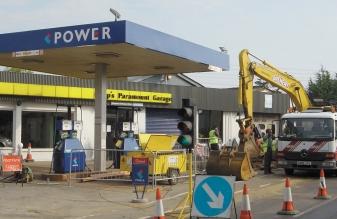
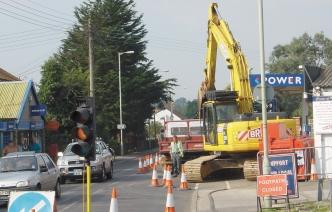
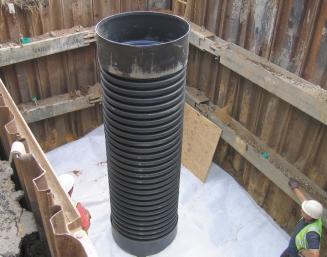
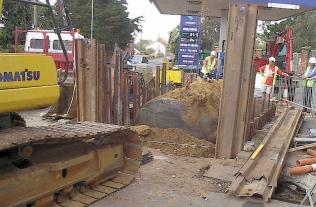
pressure put on the shell by the delivery pierced a hole through the corroded bottom of the tank.
Once the underground leak had been confirmed work began immediately to try and safeguard the nearby borehole. Fourteen monitoring holes were positioned around the petrol forecourt and the pumping station to establish the extent of contamination and to give early warning if the diesel was threatening the borehole.
To reduce the risk of further contamination, the soil down to groundwater level around the tank had to be dug out. Officers also felt it necessary to remove the faulty tank to allow access to underlying soil and ground water. The removal of the tank and contaminated soil helped with the installation of the recovery pipe work and deep sump for longer-term monitoring and recovery work.
The pumping station will now be out of action for about a year as a purely precautionary measure.
MIC has not been traditionally been linked with underground storage tanks on filling stations. However, in the last few years a number of cases have occurred on tanks as young as five years old.
Mr Smith's insurance policy covered him for the leak, as it was deemed the leak had been caused by natural elements. If it had been caused by a lack of maintenance the insurance cover would not have been effective. Mr Smith's insurance
